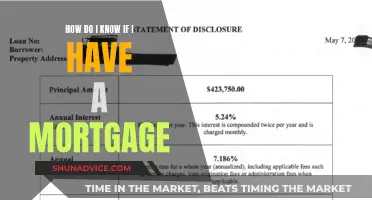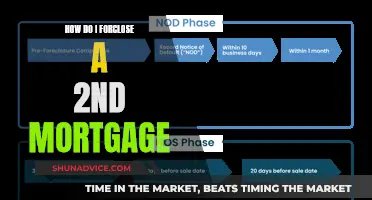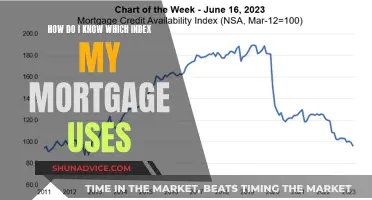Tracker mortgages are a type of variable rate mortgage that follows an external interest rate, usually the Bank of England's base rate. This means that the interest rate and monthly repayments can change during the term of the mortgage. If you have a tracker mortgage, your interest rate and monthly repayments will go up or down in line with any changes to the base rate. Tracker mortgages are typically available for a set period, after which you will usually be moved to the lender's standard variable rate, which is often higher. This is a good time to remortgage or switch to a fixed-rate deal.
| Characteristics | Values |
|---|---|
| Type | Variable rate mortgage |
| Tracking | Usually tracks the Bank of England's base rate |
| Interest rate | Variable |
| Repayments | Variable |
| Term | Usually for a set period of time, typically 1-5 years |
| Collar rate | Some tracker mortgages have a minimum rate |
| Switching | Possible to switch to a fixed-rate mortgage |
| Early repayment | May be charged a penalty |
What You'll Learn

Tracker mortgages are variable rate mortgages
There are two main types of tracker mortgages: those that are available for a short time, usually between one and five years, and lifetime trackers, which last for the full term of the mortgage. After a short-term tracker mortgage ends, you'll usually be moved to the lender's standard variable rate, which could result in higher monthly payments. This is a good time to assess your options and consider remortgaging with another tracker mortgage or switching to a fixed-rate deal.
Tracker mortgages have several advantages. Introductory tracker rates can be very competitive and may be lower than other mortgage deals. Additionally, if the base rate falls, your monthly payments will also decrease, potentially allowing you to overpay and reduce the total amount of interest you pay. However, it's important to remember that your payments can also increase, so you need to be prepared for higher payments at any time and ensure that you can still afford your mortgage if this happens. Some tracker deals also have a collar or floor, which means that your payments won't drop below a certain level, even if the base rate falls.
Is Your Mortgage Current? How to Check and Confirm
You may want to see also

They follow the Bank of England's base rate
Tracker mortgages are a type of variable-rate mortgage that "tracks" a base rate, usually the Bank of England's base rate. This means that the interest rate on a tracker mortgage is dependent on the Bank of England's base rate and will change when the base rate changes. If the base rate increases, the interest rate on the tracker mortgage will also increase, leading to higher monthly repayments. Similarly, if the base rate drops, the interest rate on the tracker mortgage will also decrease, resulting in lower monthly repayments.
The interest rate on a tracker mortgage is typically set at a fixed percentage above the Bank of England's base rate. For example, if the base rate is 0.75%, the tracker mortgage rate might be 1.75% (base rate plus 1%). This additional percentage is often influenced by factors such as your credit score, loan-to-value ratio, and other factors considered by the lender.
It is important to note that tracker mortgages can have introductory periods, usually between one to five years, after which you may be moved to the lender's standard variable rate, which could result in higher monthly payments. Lifetime tracker mortgages, on the other hand, do not have a fixed end date and track the Bank of England's base rate for the full term of the mortgage.
In recent years, some lenders have introduced "collar rates" or "floors" on their tracker mortgages, which means that your rate cannot go below a certain minimum level. This ensures that even if the base rate drops significantly, your monthly mortgage payments will not decrease below the specified minimum rate.
Overall, tracker mortgages offer the advantage of potentially lower interest rates and the ability to make larger payments towards the principal balance early on. However, it is essential to be prepared for potential increases in monthly repayments if the Bank of England raises its base rate.
Freddie Mac: Who Owns Your Mortgage and How to Know?
You may want to see also

Your monthly payments can go up or down
Tracker mortgages are variable-rate mortgages, which means your monthly payments can go up or down depending on changes in the Bank of England's base rate. This base rate is used to help control inflation and prevent prices from rising too quickly. Usually, tracker mortgages are set at one percentage point above the base rate. For example, if the base rate is 1%, the tracker mortgage rate will typically be at least 2%.
When the base rate falls, your monthly payments and outgoings should also decrease. However, it's important to note that lenders are not obligated to pass on these cuts, and some tracker deals have a 'floor' or 'collar' that prevents rates from dropping below a certain level. This means that even if the base rate drops, your monthly payments may not decrease further than the specified floor or collar rate.
On the other hand, if the base rate increases, your monthly payments and outgoings will also rise. This could leave you financially stretched, especially if the base rate increases significantly. It is important to ensure that you can still afford the repayments if the external rate rises. In such cases, you may have the option to switch to a fixed-rate mortgage, which offers more predictability in monthly payments.
The variable nature of tracker mortgages can be advantageous when the base rate is low, as it provides an opportunity to make larger payments towards the principal balance. This can help you reduce the overall interest paid on your mortgage. Additionally, tracker mortgages often have competitive introductory rates, which can be lower than other mortgage deals.
Understanding Your Mortgage: Finding the Principal Balance
You may want to see also

They usually last 1-5 years
Tracker mortgages are usually agreed on for a set period, typically 1-5 years. After this period, you will usually be moved to the lender's standard variable rate, which is often higher. This is a good time to look at your options and consider remortgaging with another tracker mortgage or finding a fixed-rate deal.
Tracker mortgages are often available for a short time, like the first 1-5 years of your mortgage. However, you might be able to get a tracker mortgage for the life of your loan. Lifetime tracker mortgages track an external interest rate, usually the Bank of England base rate, for the whole term of the loan. They have no fixed end date and are usually ''switch and fix'' mortgages, allowing you to move to a different rate without an exit charge.
If you decide to switch to a fixed-rate mortgage, you may not need to find a new mortgage provider. Some providers allow you to switch without any fees or early repayment charges. However, it's important to note that early repayment charges may apply, and these fees can vary depending on the lender.
Overall, the duration of a tracker mortgage can vary, but it is typically 1-5 years. After this period, you have the option to switch to another tracker mortgage or explore alternative options like fixed-rate mortgages.
Finding Proof of Paid-Off Mortgages
You may want to see also

You can switch to a fixed-rate mortgage
Tracker mortgages are a type of variable-rate mortgage, which means that your monthly payments can increase or decrease in line with any changes in the Bank of England's base rate. This means that you may never be able to predict or plan your mortgage payments in advance, and you could end up paying more every month.
If you are on a tracker mortgage and are looking for more stability and predictability in your monthly payments, you can switch to a fixed-rate mortgage. Fixed-rate mortgages offer a set interest rate that remains the same for the length of the deal, typically between 2 and 10 years. This means that your monthly payments will not fluctuate with interest rates and you will be able to budget more effectively.
To switch to a fixed-rate mortgage, you will need to compare different mortgage providers and products to find the best interest rates, fees, and repayment terms that fit within your budget. You can do this by researching online, using comparison websites, or speaking to an experienced mortgage broker who can advise you based on your circumstances.
It is important to note that switching your mortgage deal before the end of your current term may result in early repayment charges. However, some lenders may allow you to apply for a product transfer up to 6 months before your current deal ends, or at any time if you are already on the Standard Variable Rate (SVR). Therefore, it is recommended to carefully review the terms of your current deal and weigh the costs of switching against the potential savings of a new mortgage product.
Additionally, when switching to a fixed-rate mortgage, consider the features of your new deal. For example, some deals may offer the ability to make unlimited overpayments without charge, while others may have limits or incur additional fees. It is important to understand all the features and conditions of your new mortgage deal before making the switch.
Foreclosing on a Second Mortgage: What You Need to Know
You may want to see also
Frequently asked questions
A tracker mortgage is a type of variable rate mortgage that tracks a base rate, usually the Bank of England's base rate. This means that the interest rate on your mortgage will fluctuate in line with changes to the base rate.
Unlike a fixed-rate mortgage, a tracker mortgage does not have a fixed interest rate. This means that your monthly repayments can go up or down depending on changes to the base rate. Tracker mortgages are also different from standard variable-rate mortgages and adjustable-rate mortgages (ARMs).
You likely have a tracker mortgage if your mortgage contract states that it follows the Bank of England's base rate. Additionally, your mortgage deal may specify an introductory period, typically between 1-5 years, after which you will be moved to the lender's standard variable rate.







